
By Richard Arculus, Igneous Petrologist, Professor of Geology Research - School of Earth Sciences, Australian National University
September 14, 2012
1619 GMT
Wind – NE @ 5 kts
Air Temperature – 25.9°C (78.7°F)
Sea State – 2.2m
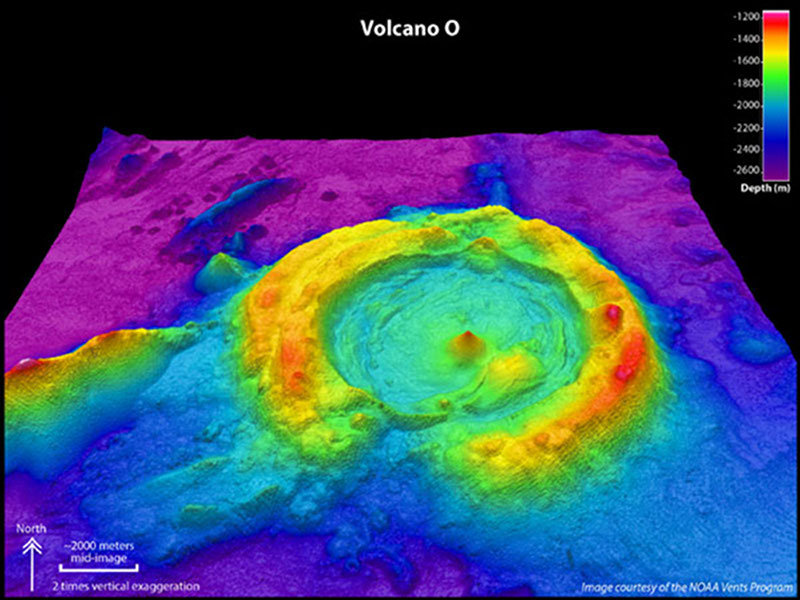
Volcano O, a huge caldera in the Northeast Lau Basin. Image looks toward the north, 2 times vertically exaggerated. EM300 and EM122 multibeam bathymetry grid cell size is 35 meters. Image courtesy of Susan Merle OSU, Submarine Ring of Fire 2012 Exploration, NOAA Vents Program. Download image (jpg, 110 KB).
Through Thursday night, September 13th, after exploring two fields of hydrothermal chimneys in the southern Fonualei Rifts, the R/V Roger Revelle transited northwards to one of the most remarkable volcanic structures on Earth: a giant near-circular caldera ~15 km in diameter, colloquially known as “Volcano O“, with a floor at a depth of about 2000m, and a young cone in the southeast sector rising 730m above the floor to a summit at 1270m depth below sea level. If the collapse of the former volcano at this site occurred over a limited time and in a single event, then it is likely the formation of the resultant caldera was accompanied by a major tsunami.
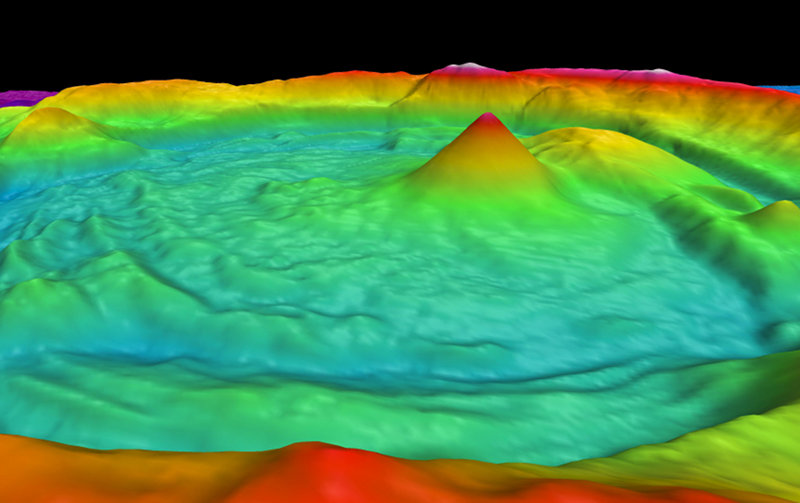
Multibeam bathymetry image of the cone in the caldera of Volcano O. The image is not vertically exaggerated, and is viewed from the west looking east. Image courtesy of Susan Merle OSU, Submarine Ring of Fire 2012 Exploration, NOAA Vents Program. Download larger version (jpg, 1.8 MB).
Volcano O is in the rear arc of the Tonga system, located some 40km west of the chain of subaerial-submarine volcanic edifices that define the volcanic front of the Tonga Arc, and 25 km east of the spreading ridge of the Northeast Lau Spreading Center. The center of the caldera is at about 15.37°S, 174°W.
Over the past decade, the ocean science and mineral exploration community has mapped at increasing levels of bathymetric detail the morphology of the volcano, determining that the composition of the cone and surrounding floor is predominantly dacite (considerably more silica-rich than basalt). This, along with increased towing with sea-floor cameras over the cone and various parts of the caldera resulting in the discovery of at least three sources of hydrothermal particle venting, respectively on the cone’s summit and adjacent to the inner caldera walls.
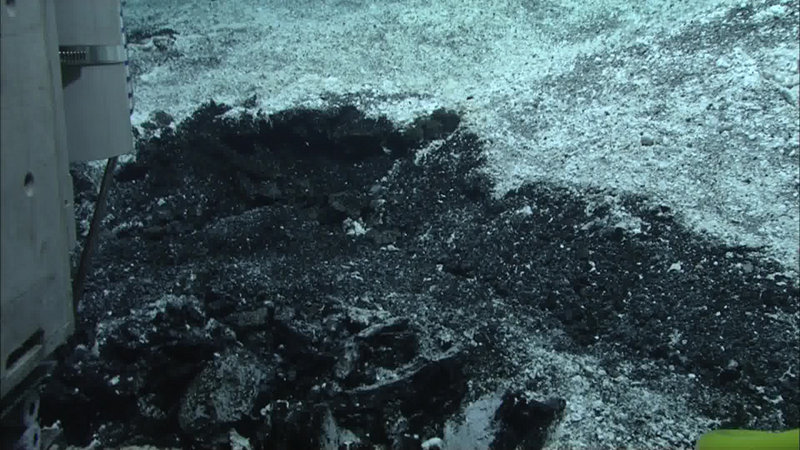
Sulfur-rich layer coating lava ash at Volcano O. Image courtesy of MARUM, University of Bremen and NOAA-Pacific Marine Environmental Laboratory. Download larger version (jpg, 549 KB).
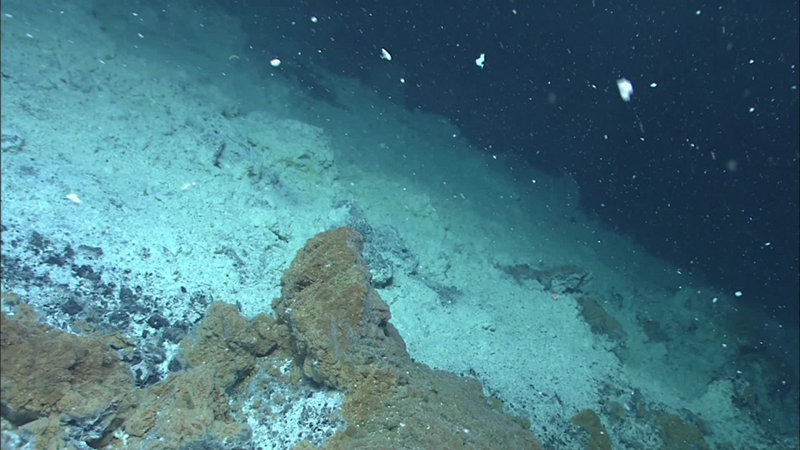
Sulfur deposited on the cone flanks and surrounding areas gives the appearance of a snow storm. Image courtesy of MARUM, University of Bremen and NOAA-Pacific Marine Environmental Laboratory. Download larger version (jpg, 577 KB).
We were determined to explore the cone in more detail, arrived on the deployment site at 8am in fine calm weather, and within the hour the MARUM team had the Quest 4000 ready to submerge. We planned to traverse from west to east over the summit and then explore around the margins of the cone. There was so much to see and sample that we could only complete the first part of this exploratory survey. As we descended to the seafloor, we passed through a dense cloud of particulates that had been detected by hydrocasts and tow-yows on previous surveys. Towards the seafloor, numerous writhing pelagic polychaete worms filled the view displayed by the video monitors.
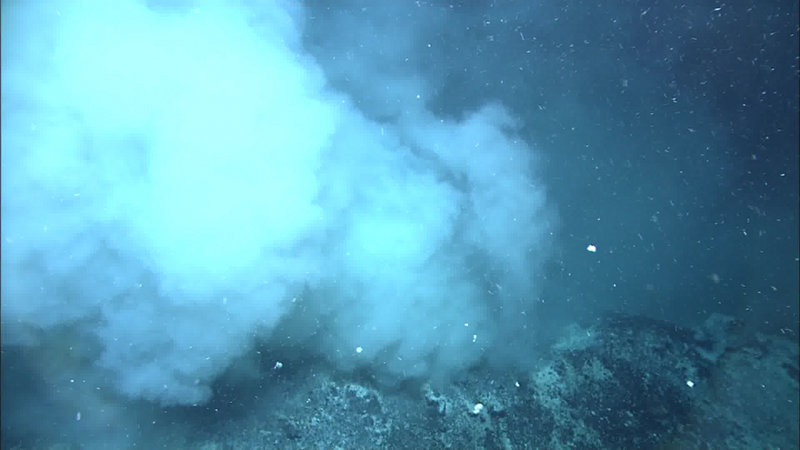
The rim of the pit crater at the cone volcano in the caldera of Volcano O. This crater is the prolific source of a sulfur particulate-rich plume, detected in several previous studies of the water column at Volcano O. Image courtesy of MARUM, University of Bremen and NOAA-Pacific Marine Environmental Laboratory. Download larger version (jpg, 249 KB).
We found the summit of the cone is mantled with a ubiquitous sulfur-rich layer, coating rugged pillowed lava blocks, lava tubes, and pyroclastic glass-rich ashes and blocks. A surprise for us, previously unrecognized in our multibeam sonar-derived bathymetry, was the presence at the cone’s summit of an elongated (NE-SW) pit crater. This crater is the prolific source of a sulfur particulate-rich plume, detected in several previous studies of the water column at Volcano O. Shimmering clear water wells up in numerous places through the loosely agglomerated pyroclastic materials forming the rim of the crater and down the flanks of the cone. The highest temperature we measured in these pyroclastic materials was ~105oC. Given the temperature of the water emanating at the pit crater rim, there is a possibility of a molten sulfur lake on the floor of the crater. However, our attempt to descend into the pit for a closer look was thwarted by the density of the clouds of sulfurous “smoke“. Frozen elongate lobes of sulfur descend the cone flanks, while sulfur ribbons and fragments give the appearance of a snow storm enveloping the flanks. Insert Image of Snow Minute native sulfur beads are prevalent among the pyroclastic fragments mantling the edifice. While bacterial mats, shrimp, crabs and fish colonize the deeper flanks of the cone, the upper portion seems to be hostile to life, likely the result of increased acidity of the water.
We departed the base of the eastern flank of the cone at 0600 GMT heading for the surface, replete with samples for the biologists, zoologists, hydrochemists, and petrologists along with video and still imagery, fully aware that much remains to be discovered specifically of the cone, but more generally the development, present state, and potential future activity of this immense Volcano.